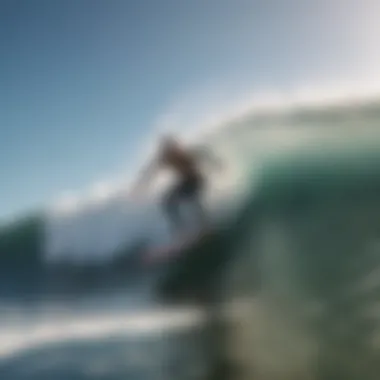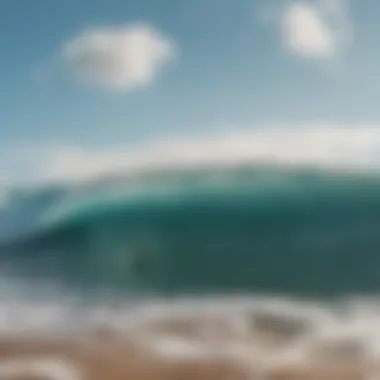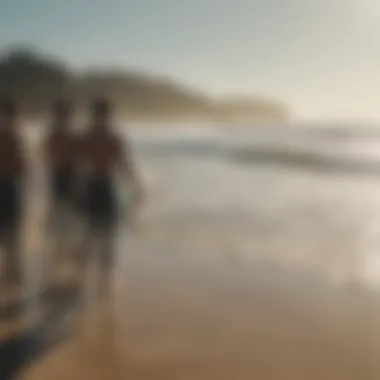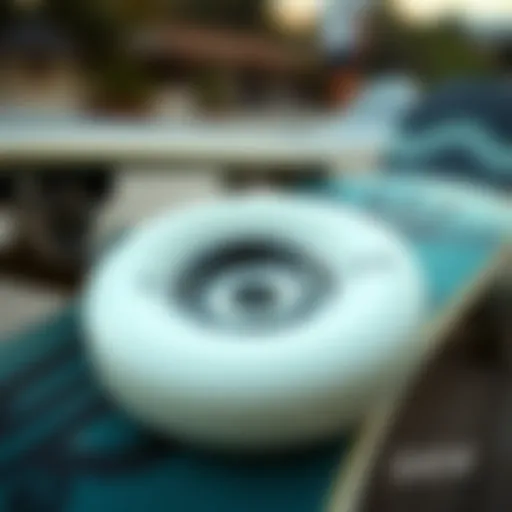Exploring Surf Mode: Enhancing the Surfing Experience


Intro
Surfing is more than just a sport; it embodies a lifestyle that couples with nature and deep instincts. Within this realm, the phenomenon known as 'surf mode' emerges as a pivotal concept. It is a state of being that intertwines a surfer's mental focus, physical abilities, and technical proficiency. The impact of surf mode extends beyond individual performance, playing a significant role in shaping the broader culture of surfing. Through this exploration, we delve into what makes surf mode an integral part of the surfing experience, its components, and how surfers, both new and seasoned, can cultivate it for enhanced enjoyment on the waves.
Surf Gear and Equipment
Having the right equipment can significantly elevate one's surfing experience and effectiveness on the water. As surfers seek to attain that ideal surf mode, the gear they choose plays a crucial role in achieving their objectives.
Latest Surfboard Technologies
The evolution of surfboards is nothing short of fascinating. Innovations have reshaped the way surfers interact with the ocean. Today's surfboards are lighter, more durable, and tailored for different surfing conditions. For instance, advancements in materials like epoxy and carbon fiber have led to boards that hold their shape and performance characteristics longer while minimizing weight. This benefits surfers by increasing their agility and response time on the waves.
Consider, for example, the rise of hybrid surfboards. These boards merge shortboard and longboard dimensions, allowing more versatility in riding styles and wave conditions. They are a godsend for intermediate surfers looking to push their limits while still offering manageable control.
Essential Accessories for Surfers
Beyond the primary surfboard, accessories can enhance both safety and performance. Essential items include
- Wetsuits: Keeping warm during chilly rides is crucial. A well-fitted wetsuit not only retains body heat but also allows for greater freedom of movement.
- Leashes: These prevent boards from drifting away after a wipeout. A quality leash safeguards not just the surfer's board but also others in the water.
- Surf Wax: Adding grip is essential for maintaining balance. Applying the right wax depending on water temperature can make a world of difference.
- Surf Traction Pads: These assist in achieving solid footing. They provide an extra layer of grip and can improve control over the board, especially in challenging conditions.
"Each piece of gear is a step towards achieving that zen-like state known as surf mode; choosing wisely can make all the difference."
Techniques and Skills
Understanding the nuances of surfing techniques is vital for those aiming to reach their full potential. Getting into surf mode requires blending multiple skills and approaches elegantly.
Wave Riding Strategies
Mastering the art of riding waves involves more than just paddling out and catching the next big swell. Experienced surfers often analyze wave patterns and currents to determine the best times to catch a wave.
- Positioning: Knowing when to get in the right spot can mean the difference between catching a wave and being left behind.
- Paddling Techniques: Effective paddling can propel a surfer toward a wave's peak, enhancing their chances of a successful ride.
- Weight Distribution: Shifting weight according to the wave's movement can help maintain balance and ensure smoother transitions.
Safety and Surf Etiquette
While the thrill of catching a wave can be exhilarating, understanding safety measures and etiquette is vital, especially in crowded line-ups. Key points include
- Respecting Priority: Always yield to surfers already riding a wave to maintain harmony and reduce accidents.
- Keeping a Safe Distance: Maintaining personal space in the water helps prevent collisions, which can be dangerous.
- Awareness of Conditions: Before heading out, it’s prudent to check for hazards like rip currents or hostile marine life. Safety needs to be paramount.
Understanding Surf Mode
Understanding surf mode is not just a passing fancy for surfers; it’s a key component that can fundamentally shift the experience on the waves. It allows an individual to interact with the ocean in a unique way, where intuition and skill coalesce, creating moments that resonate long after the last wave has been ridden. Surf mode encompasses a blend of mental acuity, physical readiness, and environmental awareness, all of which are crucial for anyone serious about surfing.
The essence of surf mode lies in its transformative potential. When surfers achieve this state, they often speak of a deep connection to both the surfboard and the ocean, making it easier to absorb the rhythm of the waves. With the right mindset and physical preparation, surfers can navigate challenging conditions and enhance their performance significantly.
As surfers delve into this concept, they will be better equipped to tackle not just the waves but also their own psychological barriers, enhancing their overall experience. Moreover, understanding surf mode also bridges the gap between sportsmanship and community, allowing surfers to bond over shared challenges and triumphs in the water.
Defining Surf Mode
Surf mode can be defined as an optimal state of mind where a surfer aligns fully with their environment, exhibiting heightened awareness and performance. This mode is characterized by several critical attributes, such as fluidity, concentration, and an instinctual understanding of wave dynamics. Achieving surf mode is akin to an artist being in the zone; it’s not merely about riding on the crest of a wave but also about becoming one with it.
The importance of recognizing and defining surf mode cannot be overstated. It offers surfers a framework through which they can evaluate their performance and make necessary adjustments. In this way, surf mode becomes not just a personal experience but also a communal understanding among surfers, fostering a culture that values skill and mindfulness.
The Psychological Aspects
Flow State in Surfing
The concept of flow state is central to understanding surf mode. It refers to that exhilarating moment when everything clicks—the surfer, the board, and the wave are in sync. It’s that point where time seems to dissipate, and the world melts away. Surfers who tap into this state often describe it as being almost meditative; the focus narrows down to just riding the wave.
What makes flow state so appealing is its ability to enhance performance naturally. Surfers often find themselves executing maneuvers they hadn’t practiced, as if an instinctive knowledge takes over. However, the challenge lies in achieving this state consistently. Not every surf session will be a flow experience, but those that are can redefine what it means to ride the wave.
Dealing with Pre-Surf Jitters
Every surfer has faced those pre-surf jitters at one point or another. It’s a unique blend of excitement and anxiety that can sometimes be overwhelming. The reality is that these emotions are perfectly normal. Dealing with them effectively involves a combination of mental preparation and physical readiness. Mindful breathing techniques and visualization exercises can be incredibly helpful in calming the nerves, allowing the surfer to approach the waves with a clear mind.
Pre-surf jitters can act as a double-edged sword. On one hand, they signal that the surfer is invested; on the other, they can cloud judgment. Thus, learning to harness them rather than suppress them is what separates the seasoned surfers from the novices.
The Role of Focus


Focus is the linchpin that ties together all aspects of surf mode. Whether it’s on the wave or preparing on the beach, maintaining concentration ensures that surfers are attuned to their surroundings and the changing conditions of the water. Disruptions in focus can lead to missed opportunities or, worse, accidents.
To cultivate effective focus, surfers can practice both mental drills and physical exercises that train the mind to stay present. This adaptability can make a significant difference in performance levels, whether one is conquering small swells or massive breaks. While the sea is unpredictable, a strong focus can provide a stable anchor, enabling surfers to navigate ever-changing environments.
Physical Preparations
Warming Up Exercises
Warming up is a critical but often overlooked element of preparing for a surf session. Simple stretching and mobility exercises can enhance flexibility, reduce the risk of injuries, and improve overall performance in the water. A few effective warm-ups include arm circles, leg swings, and lunges, which get the blood flowing and prepare the body for action.
These exercises highlight the need for physical readiness. Surfers who consistently incorporate a warming-up routine into their practice report not only improved performance but also increased enjoyment in their sessions. When the body is primed and ready, the mind can also shift smoothly into surf mode.
Building Endurance and Strength
Building endurance and strength is vital for any surfer who wants to maximize their time on the waves. Surfing can be incredibly taxing, especially in challenging conditions. Incorporating cardio and strength training routines can be beneficial. Everything from running to weight training reinforces core strength, which is crucial for maintaining balance on the board.
Developed endurance allows surfers to paddle longer and more efficiently, making it easier to catch waves. However, it’s essential not to overdo it; finding the right balance between training and recovery ensures that surfers are always in top shape without risking burnout.
Nutrition for Optimal Performance
Nutrition plays an indispensable role in achieving peak performance in surfing. Eating the right foods can boost energy levels and promote quicker recovery. A well-rounded diet rich in proteins, healthy fats, and complex carbohydrates fuels both body and mind, ensuring that a surfer has the necessary stamina for a lengthy session.
Individual dietary preferences can vary widely among surfers, but focusing on whole foods, such as fruits, veggies, and lean proteins, is generally a solid approach. Understanding the body’s needs and how food impacts performance is a game changer, leading to improved outcomes on the waves.
"Surfing is not just about the thrill of the wave; it’s an intricate dance between mind, body, and the ocean."
In summary, understanding surf mode involves recognizing the interplay of psychological and physical factors that contribute to an enhanced surfing experience. By immersing oneself in this knowledge, surfers can navigate the numerous challenges they face in and out of the water, strengthening both their skills and their connection to the sport.
Techniques to Achieve Surf Mode
Achieving surf mode is no walk in the park, but the right techniques can streamline the journey into that coveted state of flow. The importance of these techniques cannot be overstated; they serve as the building blocks of performance, enhancing not just skill but also the overall surfing experience. By honing specific skills, surfers can tap into their full potential and respond adeptly to the ever-changing nature of waves. This section delves into mindfulness, technique improvement, and the idea of being present, all pivotal elements in the quest for surf mode.
Mindfulness and Surfing
Breathing Techniques
Breathing is crucial in maintaining focus and calmness while surfing. By mastering specific breathing techniques, surfers can manage their anxiety, which is essential for getting into surf mode. These techniques generally involve deep, controlled inhalations and exhalations to provide mental clarity. A characteristic feature of breathing exercises is their accessibility; they can be practiced anywhere, from land to water.
One unique aspect of breathing techniques is that they help in regulating the physiological responses to stress. Surfing can often trigger adrenaline surges, but controlled breathing allows surfers to maintain a steady heart rate. While this method may not instantly convert a novice into a seasoned surfer, the advantages of mental calmness and enhanced focus far outweigh any drawbacks.
Visualization Practices
Visualization involves mentally rehearsing surf scenarios, helping to build a mental road map of how one might navigate waves. This technique can play an instrumental role in elevating overall performance. This approach capitalizes on the human brain's ability to simulate experiences, which is not only popular among athletes but increasingly recognized in various fields of performance.
A key characteristic of visualization is its versatility; surfers can visualize everything from riding a wave to executing specific maneuvers. One of the unique features is that it makes use of mental imagery, helping to bridge the gap between practice and actual performance. The biggest challenge may lie in learning how to visualize effectively, but the advantages often include improved confidence and a sense of familiarity with challenging conditions.
Maintaining Presence
Being present in the moment transforms a regular surf session into an opportunity to connect with the waves and environment. This practice emphasizes the importance of focusing on current sensations rather than worrying about past mistakes or future waves. One noteworthy aspect of maintaining presence is its alignment with mindfulness principles, making it easier for surfers to optimize their performance.
A significant benefit of this technique is that it fosters a deeper connection between the surfer and the ocean. Surfers who can maintain presence often report better intuitiveness when navigating waves. The challenge here is overcoming distractions, both external and internal. Still, the upsides include richer experiences and an enhanced ability to read the conditions effectively.
Developing Your Surf Skills
Mastering the Basics
Understanding the basics of surfing serves as a foundation for progress and ultimately achieving surf mode. Mastering paddling techniques and balance greatly affects a surfer's performance. This basic skill set is indispensable, making it a cornerstone of safe and effective surfing.
A key feature of mastering the basics is that it provides the leverage to build upon more advanced techniques as surfers progress. While it may seem tedious for some, gaining a firm grasp on these fundamentals is crucial. The biggest advantage here is the heightened safety levels that come with increased skill; surfers who are grounded in basics can reduce risks associated with more challenging maneuvers.
Advanced Maneuvers
Once foundational skills are secure, developing advanced maneuvers becomes the next exciting challenge. This can include turns, aerial tricks, and rides on larger waves. Understanding the physics behind these movements enhances execution during actual surfing. This area is exciting and revelatory, often capturing the attention of both spectators and participants alike.
A standout characteristic of advanced maneuvers is the creative expression they allow. Customizing techniques makes each surfer's style unique. The challenges often include the physical demands and risk involved, especially when advancing into more complex maneuvers. However, the rewards often include a dramatic elevation in skill, allowing surfers to tackle bigger waves with confidence.
Analyzing Wave Patterns


Understanding how waves form and break is integral to becoming an expert surfer. By analyzing wave patterns, surfers can optimize their takeoffs and rides, enhancing their overall experience in the water. A key aspect of this analysis includes both observational skills and an understanding of oceanography.
Unique to this approach is the idea that preparation doesn’t just happen in the water. Surfers benefit by tuning in during low tide or other conditions, even when not actively surfing. The challenge, of course, lies in translating that knowledge into real-time decisions on the water. However, the advantages manifest in better positioning, increased confidence, and improved ride quality.
"Mastering surf techniques isn't just about skill; it's about understanding your environment and your own abilities. That’s what keeps you in surf mode."
In summary, these techniques form the backbone of successful surfing, pushing surfers toward peak performance and deeper engagements with the ocean. By focusing on mindfulness, skill development, and present awareness, surfers contribute to not just their own success but the enriching culture surrounding the sport.
The Cultural Significance of Surf Mode
Surfing transcends the mere act of riding waves; it is woven into the very fabric of communities and cultures across the globe. Surf mode, that heightened state of focus and connection experienced by surfers, carries deep cultural implications that affect both participants and observers. This section dives into the rich significance of surf mode, all while exploring the emotional connections and environmental responsibilities that come with it.
Surf Mode in Surf Culture
Shared Experiences and Community
Surfing forms a unique bond among individuals. When people gather in droves at popular beaches, they share more than just waves; they share stories, struggles, and triumphs. This common ground creates a sense of belonging, offering support during down times or when the waves just aren’t too inviting.
This shared experience, often felt in the salt air and crashing waves, builds a community that beats with its own rhythm. Community events, surf festivals, and competitions thrive on this principle, not only connecting surfers but also drawing in spectators who feel the pulse of camaraderie.
The connection to this community can also lead to deeper friendships that transcend borders, enhancing the surfing experience. However, it can sometimes come with pressure for newcomers, who may feel the weight of expectations while trying to fit in.
The Influence of Legends
Surfing has its legends, much like any sport. Figures such as Kelly Slater and Laird Hamilton are not just athletes; they embody ideals of perseverance and skill. These legends inspire newcomers and seasoned surfers alike, pushing them to reach new heights in their own surfing journeys. Their tales often become part of the folklore that surrounds surf culture, passed down in stories around bonfires and shared experiences at surf camps.
This influence isn’t just about number of accolades earned; it’s about the way these surfers have reshaped perspectives on the waves and emphasized the art of surfing. However, idolizing these figures too heavily can result in unrealistic expectations for oneself, leading to discouragement.
Art and Expression in Surfing
Surfing is not merely a sport; it is an art form where individuals express themselves through their movements on the water. Many surfers become artists in their own right, whether through photography, film, or painting, capturing the essence of surfing culture. Imagery of surfboards adorned with colorful designs or breathtaking waves serves as a visual portrayal of the artistic side of surfing, resonating deeply within the community.
The blend of sport and art fosters creativity, allowing surfers to showcase their journeys and experiences. However, critics sometimes view this melding as trivializing the sport itself, focusing on aesthetics rather than technique. Nonetheless, for many, this artistic expression is paramount; it honors the spirit of surfing as both an adventure and a canvas.
Surf Mode and Environmental Awareness
Understanding Ocean Conservation
As surfers become more immersed in the surf mode, they often develop a profound connection to the ocean. This connection inevitably leads to an awareness of environmental issues affecting coastal areas worldwide. Many surfers recognize themselves as custodians of the ocean, advocating for its preservation and engaging in efforts like beach cleanups.
Environmental consciousness prompts surfers to learn about marine ecosystems and the impacts of pollution, fostering a culture that respects nature. However, this also raises challenges; some surfers may inadvertently become disheartened by the daunting task of safeguarding the environment, creating a sense of helplessness amidst overwhelming concerns.
Sustainable Surfing Practices
The push for sustainability in surfing practices is gaining traction. Surfboards made from eco-friendly materials and companies embracing ethical manufacturing processes point to a growing acknowledgment of environmental impacts. Surfers are also adopting practices like using reef-friendly wax or choosing biodegradable products.
These sustainable choices not only help protect marine environments but also energize the community with a sense of purpose. Yet, by focusing heavily on sustainable practices, some industry players could risk profitability, leading to tension between ecological responsibility and business needs.
Impact of Surfing on Coastal Ecosystems
Surfing's relationship with coastal ecosystems is a double-edged sword. On one side, surfing can promote awareness and appreciation for the coastline’s beauty. On the other, high traffic in popular surf spots can disrupt local wildlife and habitats. This impact necessitates a balance; surfers must be mindful of their recreational choices and how they could affect the delicate ecosystems around them.
Through education and community involvement, surfers can mitigate some of these negative impacts while fostering a broader dialogue about environmental stewardship. The true challenge lies in seamlessly marrying enjoyment of the ocean with responsible behaviors that protect it.
Adapting Surf Mode Across Different Conditions
When it comes to surfing, being adaptable is key. This article dives into how surfers can tailor their approach to different conditions. By understanding these adaptations, surfers can achieve their best performance regardless of where they're riding the waves.
Beach Breaks vs. Reef Breaks
Adjusting Techniques for Different Waves
The way you adjust your technique while surfing can significantly impact your overall experience. Beach breaks generally have softer, rolling waves compared to the more powerful and sharp waves of reef breaks. This distinction alone requires surfers to rethink their strategies.
For beach breaks, a smoother, more flowing style is often effective. A surfer might focus on longer rides, taking advantage of the gentler swell. However, when transitioning to a reef break, precision becomes critical. Riders need to be sharp with their turns and timing, as the waves can break suddenly and fiercely. Therefore, mastering different techniques suited for these breaks is not just beneficial but crucial for effectively navigating each wave's unique behavior.
Safety Considerations


Safety is an unwavering priority in any surfing situation. Understanding safety considerations between beach and reef breaks is vital. Beach breaks, while often yielding gentler waves, can also have hidden dangers such as rip currents or crowded line-ups. Here, the surfer should heed wave behavior and avoid overly congested areas to minimize risks.
For reef breaks, the stakes can be higher. Sharp coral can cause serious injuries, and the force of the waves requires a heightened level of skill. Surfers must assess the conditions before paddling out. Familiarity with the local setup can also inform decisions about timing and wave selection. Being aware of your surroundings ensures a safer and more enjoyable surfing experience.
Gear for Diverse Conditions
Choosing the right gear can influence performance across varying conditions. In beach breaks, a standard shortboard might do the trick, providing maneuverability. However, on reef breaks, many surfers opt for more substantial boards that can handle high-impact situations better.
Each type of wave may also require different fins or wetsuits, depending on the water temperature and overall conditions. It’s essential to know your gear intimately. Good gear not only enhances performance but can also protect against possible injuries related to challenging environments.
Surfing in Varied Environments
Surfers often find themselves in very different water conditions. Adapting surf mode to fit these specific environments can elevate both enjoyment and skill.
Cold Water vs. Warm Water
The temperature of the water can shape one's surfing experience. Cold water surfing undoubtedly demands more from a surfer's mental as well as physical state. Surfers are forced to bundle up in thicker wetsuits, which can sometimes limit flexibility. However, warmer waters allow for lighter gear and a freer range of motion.
Despite the challenges, cold water can be invigorating. The crispness can provide a unique surfing experience that many find exhilarating. Conversely, warm waters generally lead to longer sessions but might increase fatigue due to more extended exposure to the elements without cooling off.
Urban Surfing
Urban surfing is an ever-increasing trend that essentially changes the landscape of surfing. Here, surfers might find wave options in the midst of bustling city life, usually in rivers or canal-like setups. The concrete jungle presents unique challenges but also thrilling opportunities to get on a board in non-traditional locations.
The primary characteristic of urban surfing is accessibility. Surfers can benefit from the convenience of city locations where traditional surfing spots may be far away. However, urban conditions may also introduce variable factors such as pollution and water quality, which are important to consider before catching waves.
Remote Destinations
On the other hand, seeking out remote destinations takes adaptability to a different level. These locations often promise pristine waves and fewer crowds, creating almost a paradise for surfers. The allure lies in untouched beauty, such as travel plans to get there and how to handle unexpected challenges like changing tides.
- Accessibility is a key feature: Remote spots often require planning, patience, and sometimes long hours of travel.
- Gear selection becomes fundamental for harsher conditions and fluctuating weather, which can vary drastically from typical surfing locales.
The Future of Surf Mode
When we ponder the evolution of surfing, it's impossible to dismiss how surf mode will adapt and morph in the years to come. As technology takes leaps forward and societal perceptions of what it means to surf shift, understanding this evolution becomes all the more crucial. The future of surf mode hinges on a mix of advancements in gear, innovative practices, and a growing awareness of environmental impact, all of which amplify the surfing experience.
Technological Advances
Surfing Gear Innovations
When it comes to surfing gear innovations, the surge in user-friendly equipment is a game changer. Imagine boards equipped with smart technology that taps into wave parameters or wetsuits made from sustainable materials that keep surfers warm without harming the oceans. The key characteristic here is the blend of performance and sustainability, allowing surfers to ride the waves while staying eco-conscious. This not only enhances the overall surfing experience but also aligns with a global shift towards environmentally friendly practices.
A unique feature of these innovations is their adaptability. Modern surfboards with adjustable fins enable surfers to customize their ride based on conditions, which can be incredibly advantageous as ocean patterns become more erratic with climate change.
Apps for Surf Forecasting and Training
Apps designed for surf forecasting and training are revolutionizing how surfers prepare for their sessions. These applications offer real-time data on wave conditions, wind speeds, and tide movements, empowering surfers to make informed decisions before they even hit the beach. The standout trait of these tools is their accessibility; surfers can gather crucial information right from their smartphones.
One of the most appealing features is the use of community-driven data. Many of these apps allow surfers to share their experiences or conditions, which can help others. However, a caveat exists—reliance on technology can sometimes detract from the instinctual components of surfing, a discipline that thrives on reading the ocean.
Virtual Reality in Surf Training
Virtual reality (VR) is carving out a niche in surf training, giving surfers the ability to practice their skills without ever stepping outside. Whether it's simulating the feeling of catching a wave or visualizing complex maneuvers, VR allows for a level of immersion that echos real-life surfing. This unique aspect of VR training speaks to the emphasis on fostering muscle memory and mental preparedness.
However, while VR can be a fantastic supplement, it poses some disadvantages. Nothing can fully mimic the unpredictable nature of ocean waves. Surfers might find themselves lacking the crucial adaptability needed for real-world surfing when too reliant on virtual experiences.
Emerging Trends in Surf Culture
Influence of Social Media
Social media plays a significant role in shaping today’s surf culture. With platforms like Instagram and TikTok, surfers can share their adventures and showcase their skills. The defining trait of this influence is its immediacy; a rider can upload a video of their last session within moments, reaching a global audience instantly. This not only enhances community ties but also encourages newcomers to dip their toes into the water.
However, there’s a flip side—this constant visibility may pressure surfers to put performance over enjoyment, leading to burnout or a skewed sense of identity.
Rise of Eco-Conscious Surfers
The rise of eco-conscious surfers has ushered in a cultural shift. More surfers are advocating for ocean protection and environmental sustainability, aligning their practices with active stewardship. A hallmark of this movement is the amalgamation of surfing with notions of conservation, making individual surfers advocates for the health of our oceans.
This trend often leads to unique collaborations between surf brands and environmental organizations, pushing forward initiatives that aim to combat plastic pollution and protect marine ecosystems. Yet, the challenge remains in ensuring that these efforts do not become mere marketing gimmicks.
Global Surf Competitions and Collaborations
Lastly, global surf competitions and collaborations are painting a new picture of surf culture. Events like the World Surf League have gained immense popularity, drawing athletes from different corners of the globe. The core characteristic here lies in the spirit of unity and competition that transcends borders, putting surfing on a larger stage.
The unique feature of these competitions is their capacity for community-building. They often bring together diverse groups of surfers and fans, fostering cross-cultural exchanges. A downside to consider, though, is that the pressure to perform in competitions can sometimes overshadow the pure joy of surfing for many individuals.















